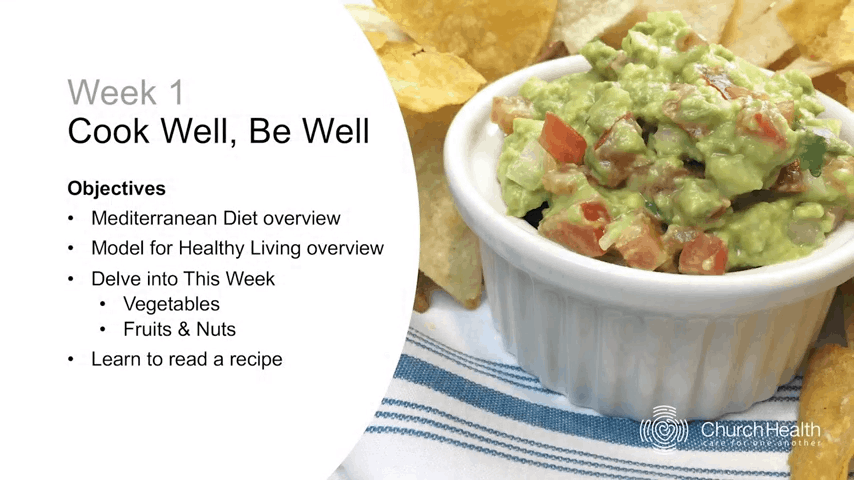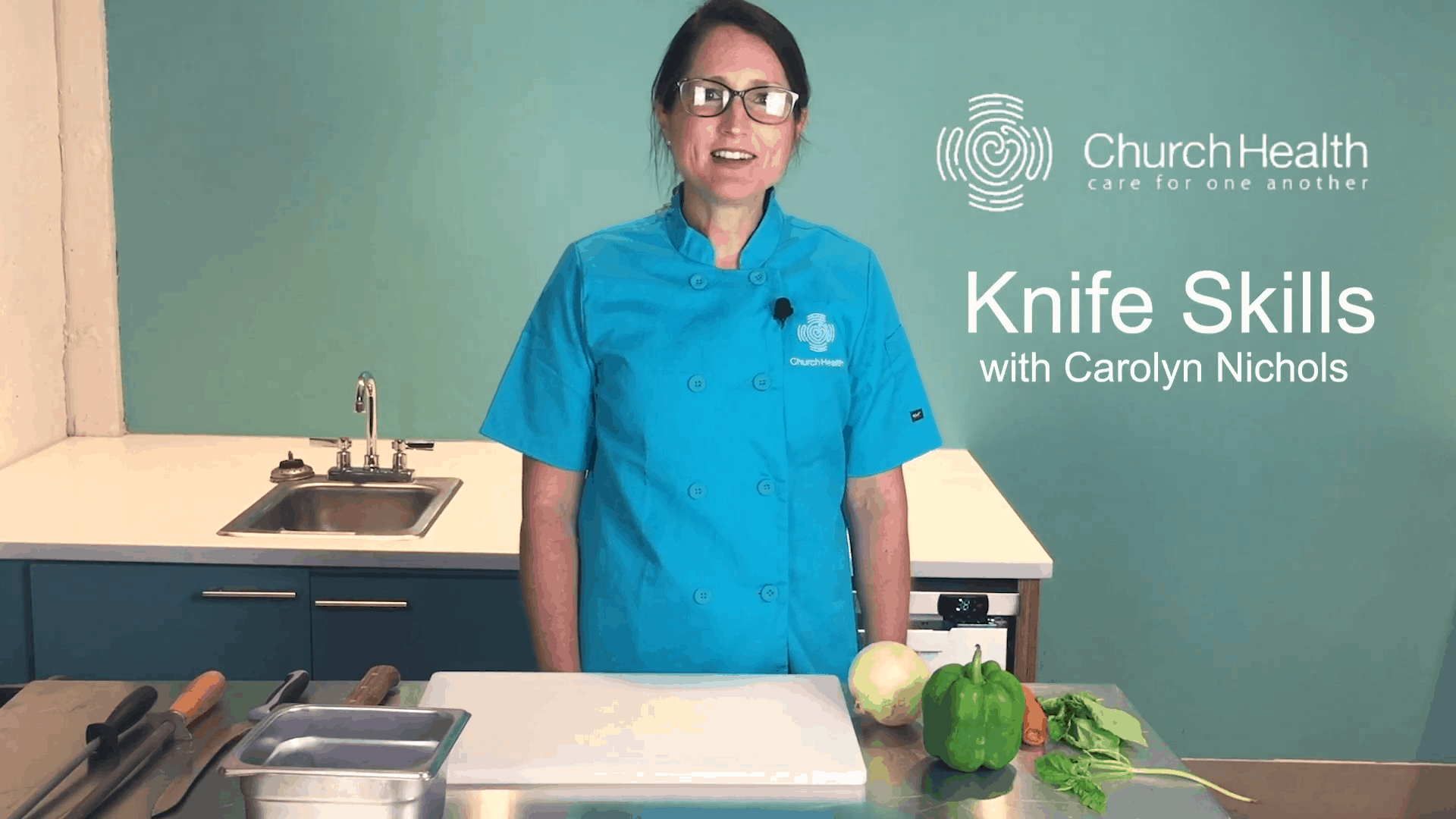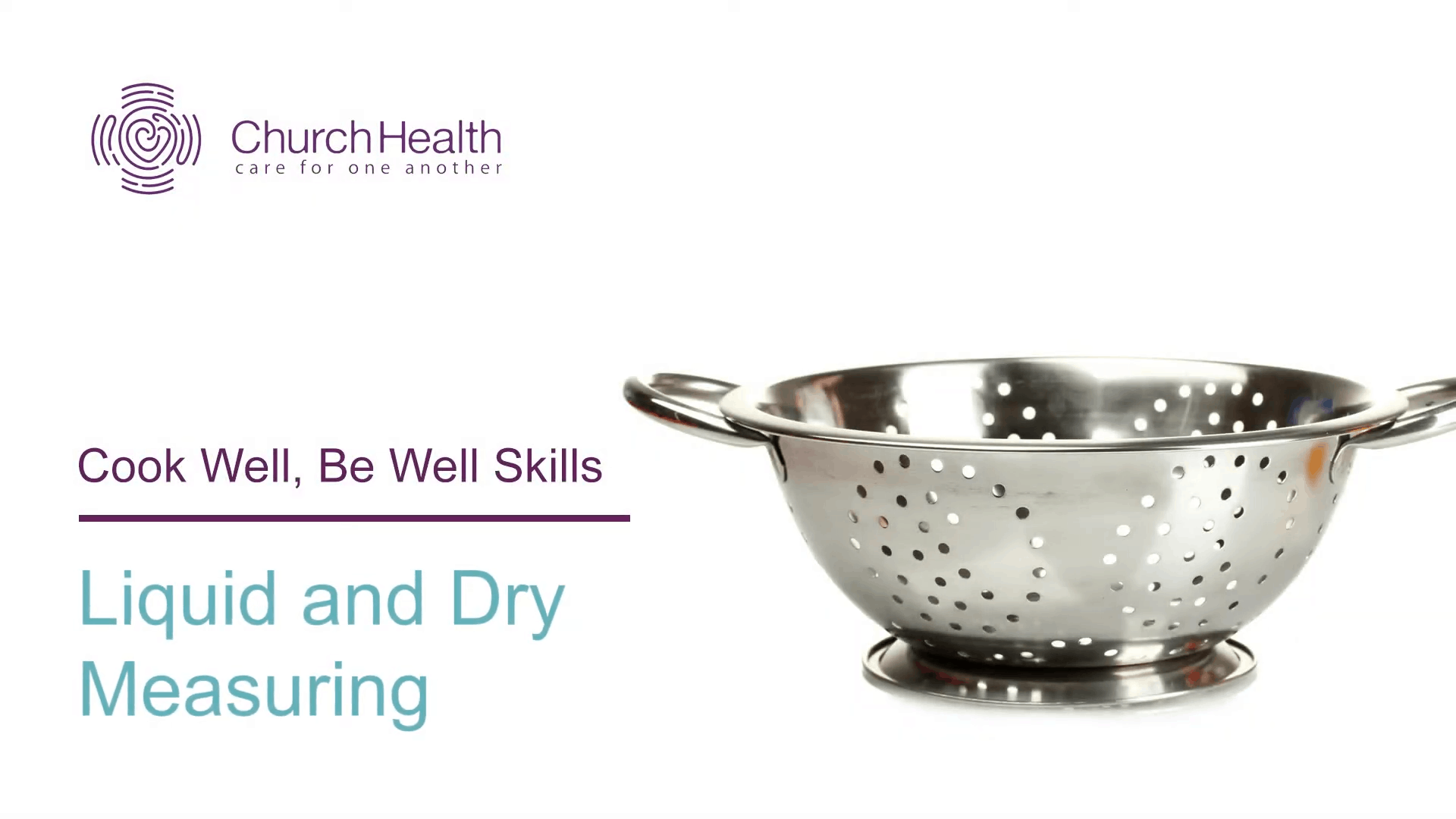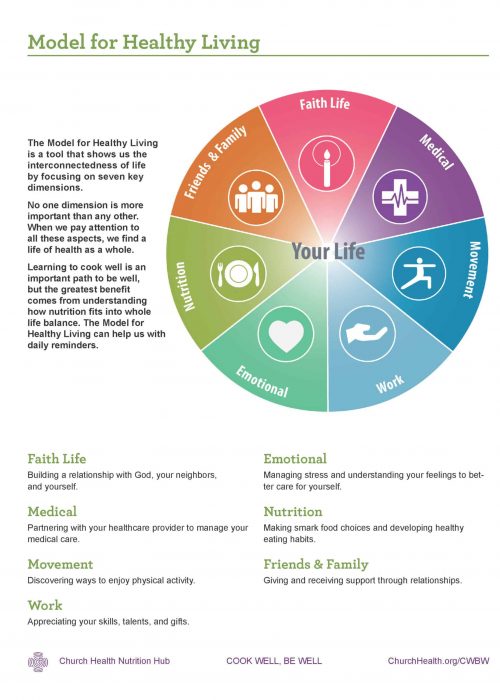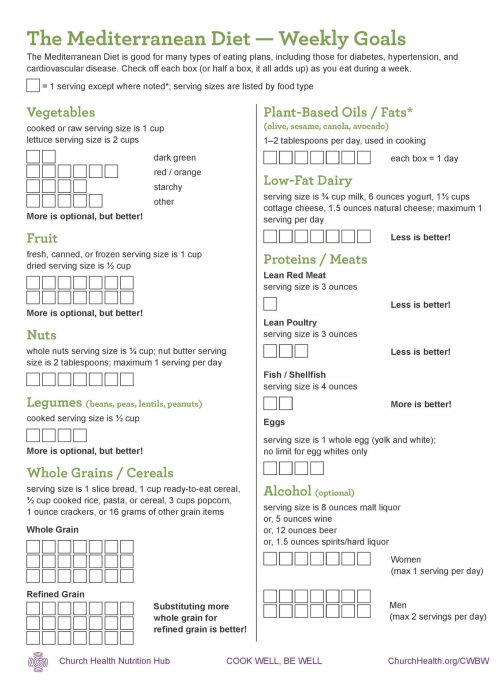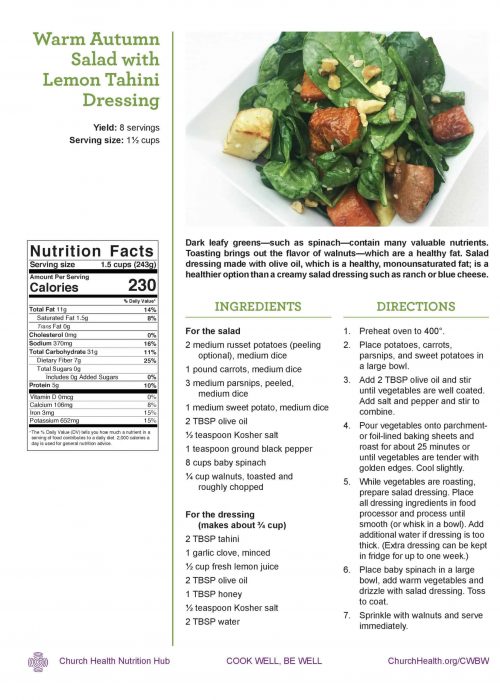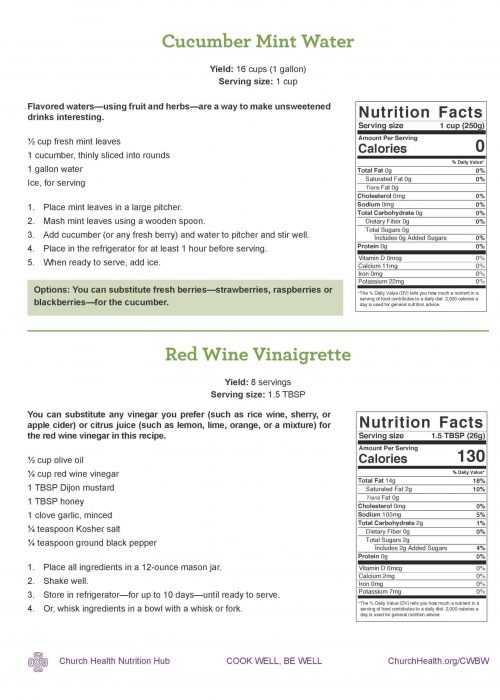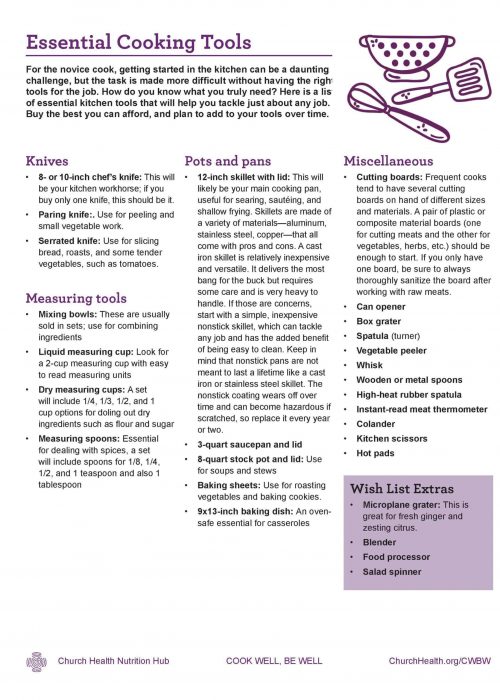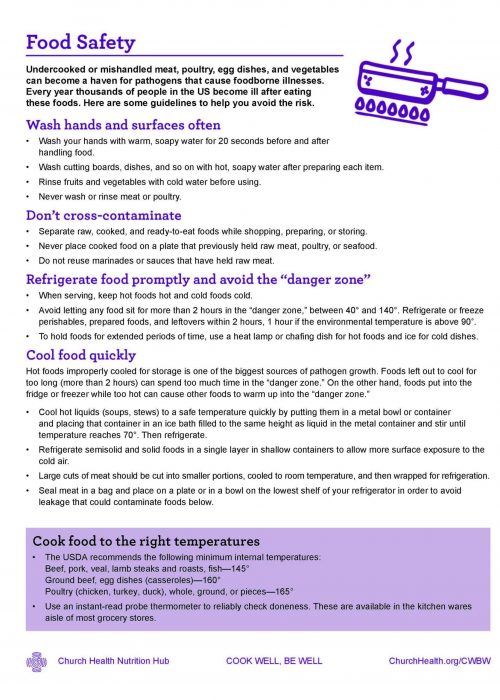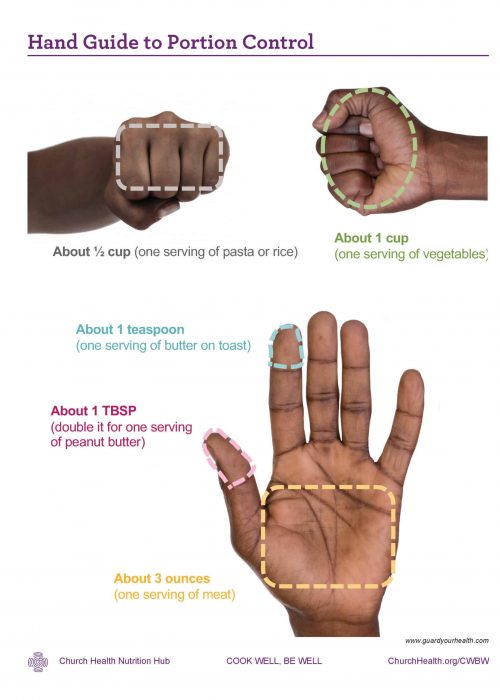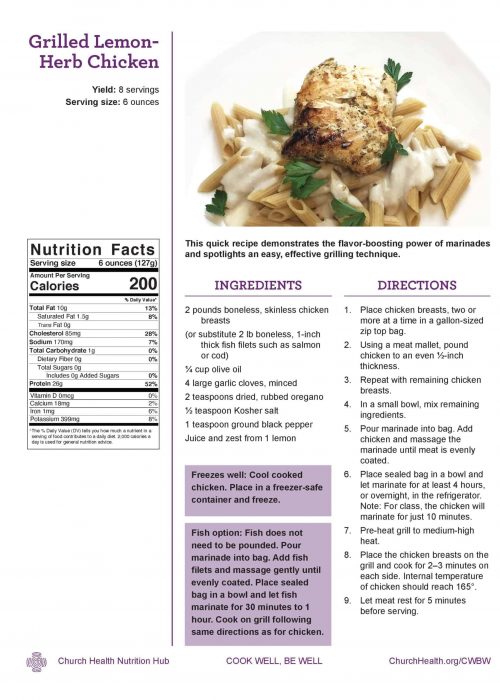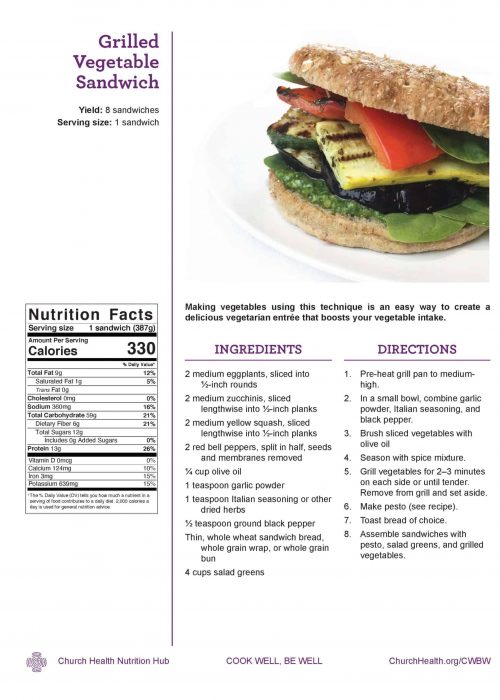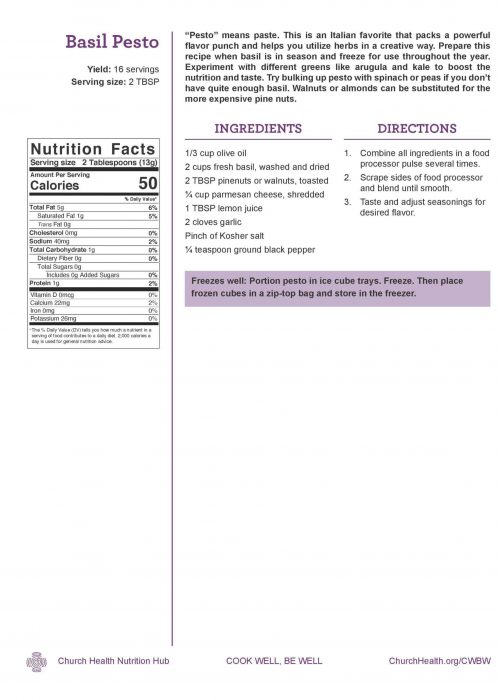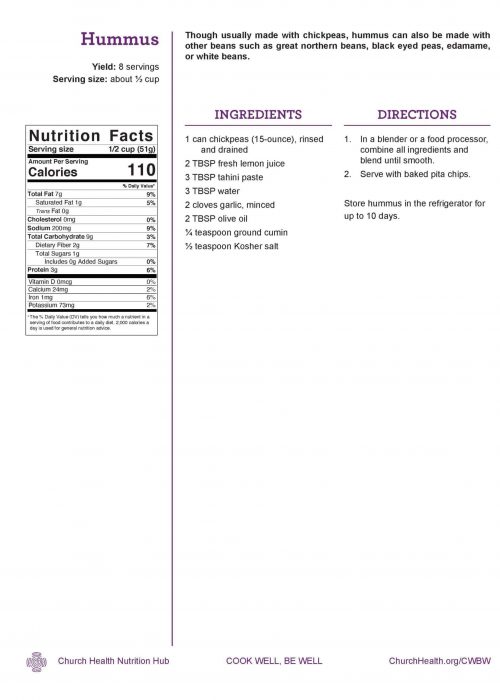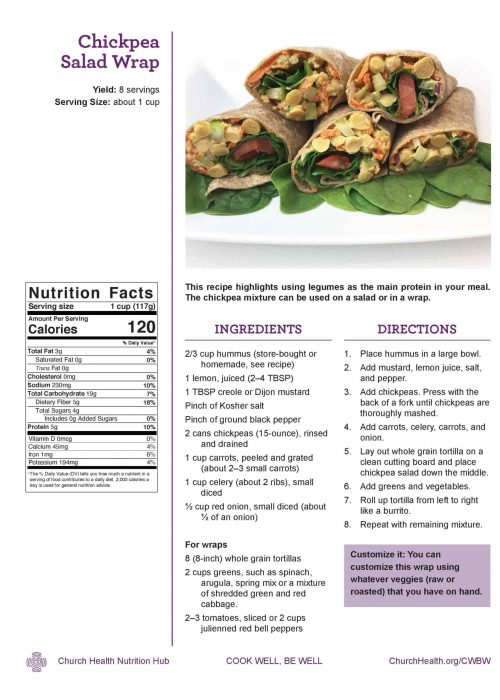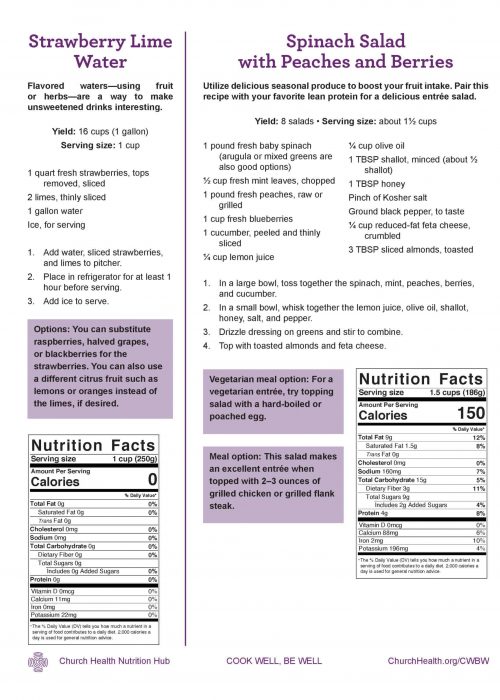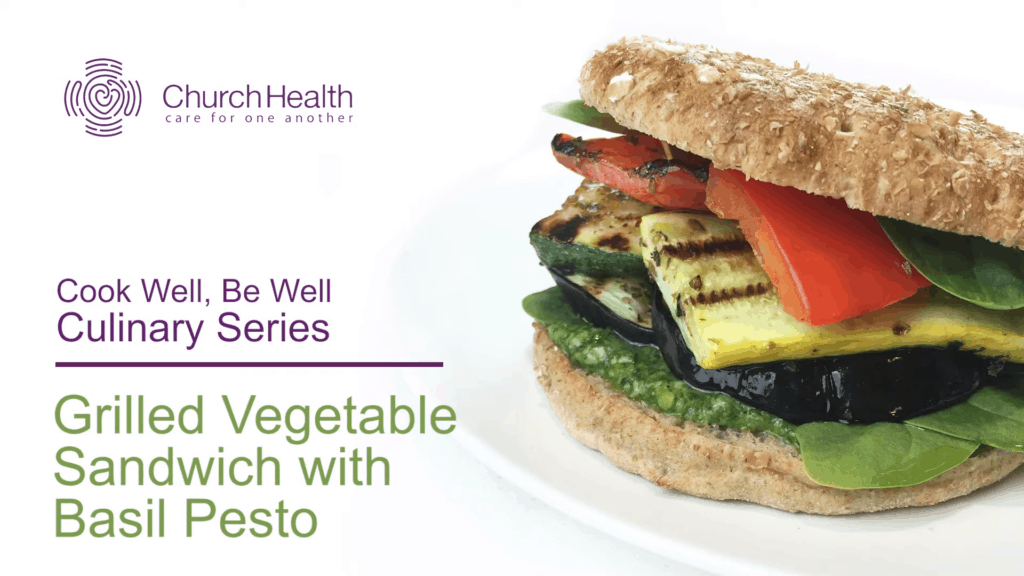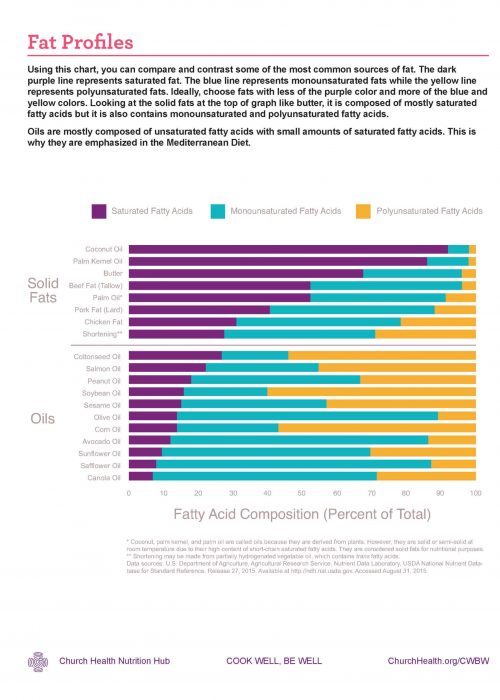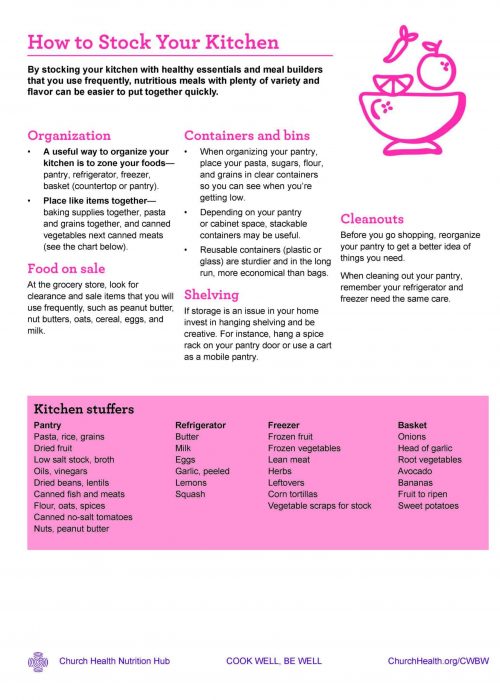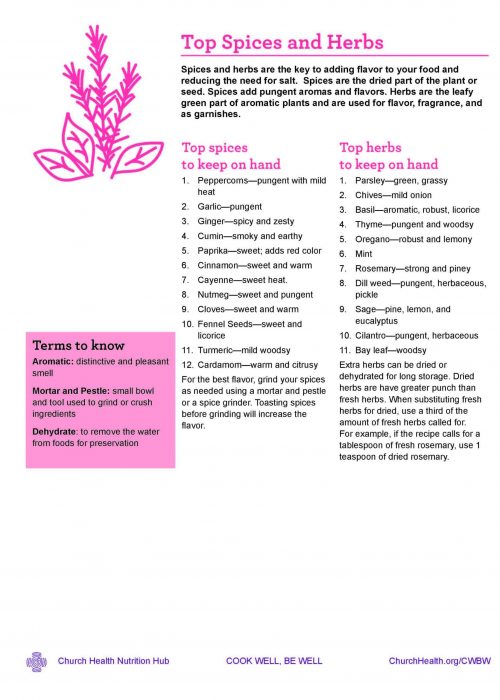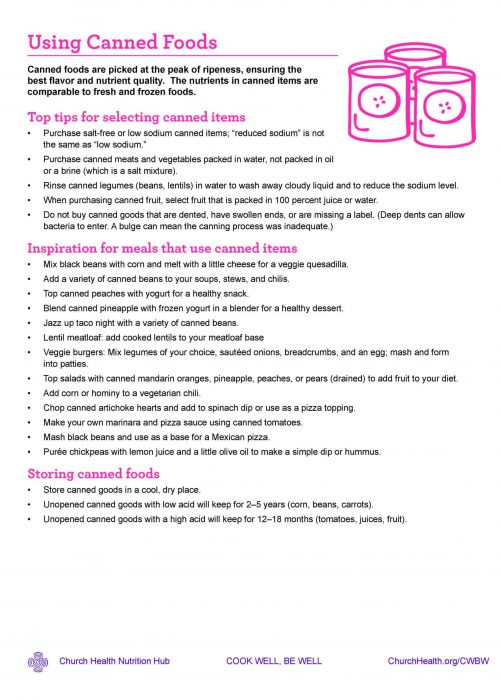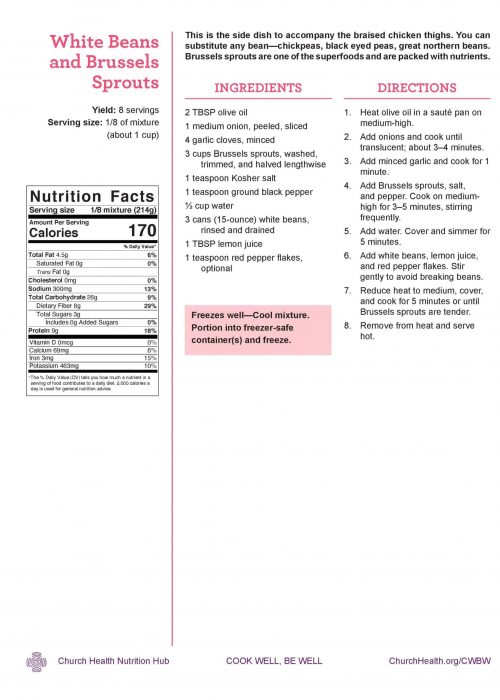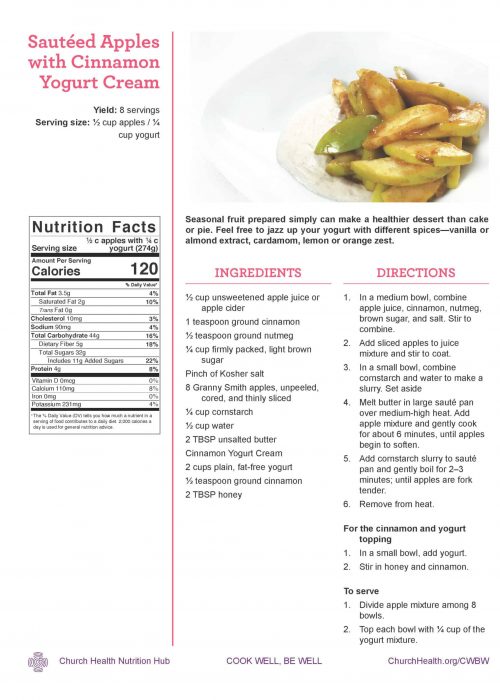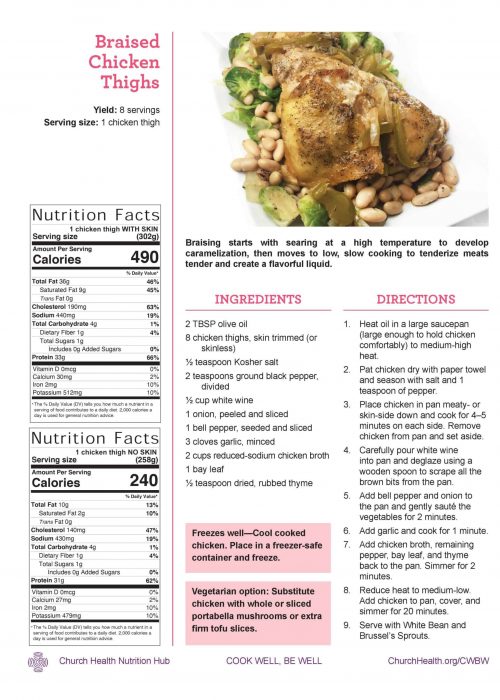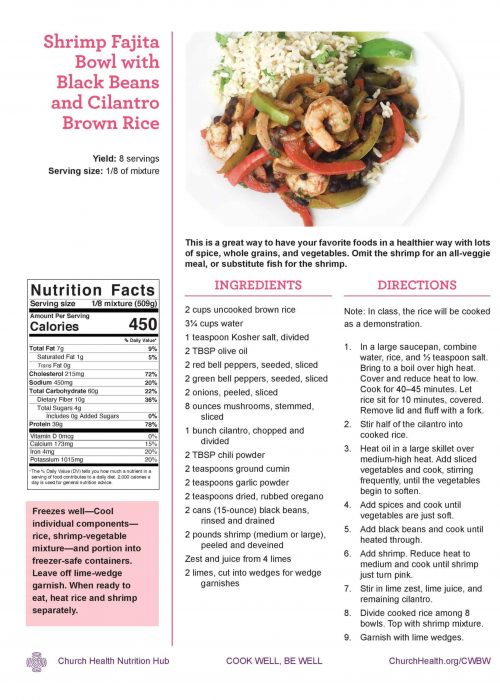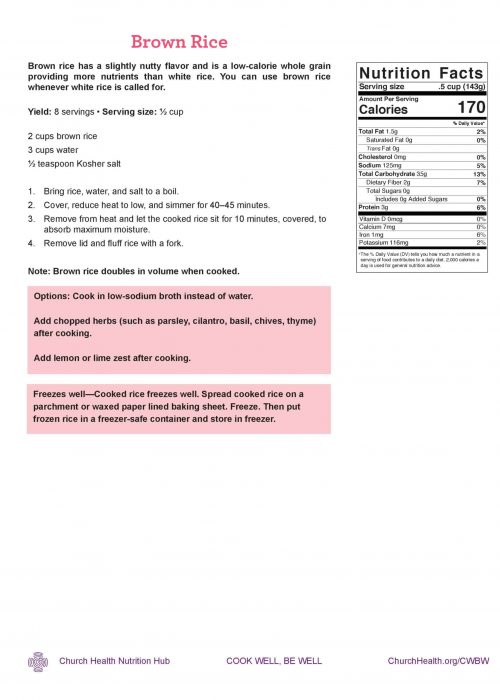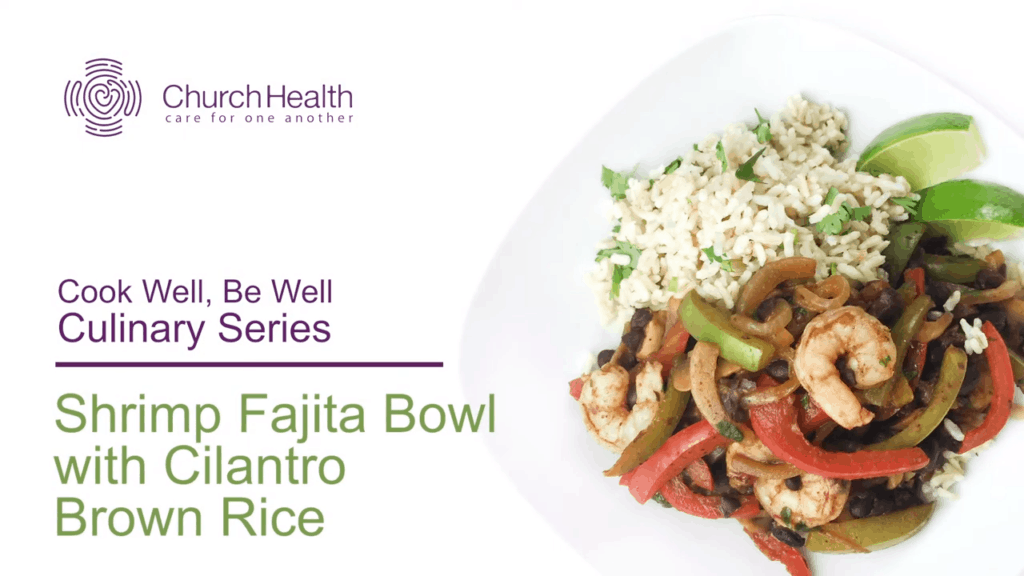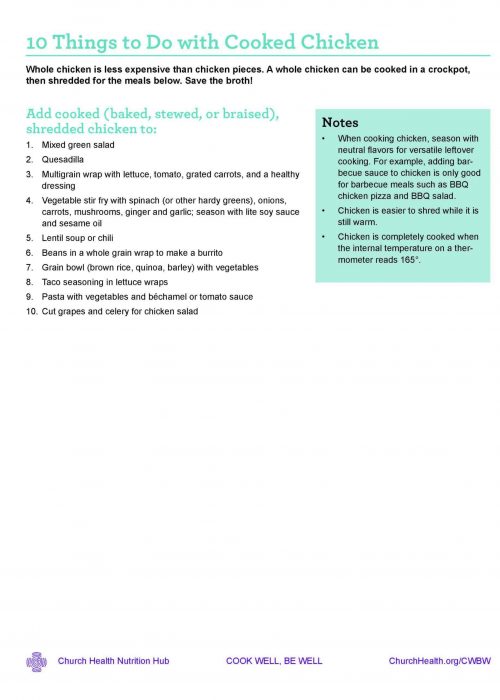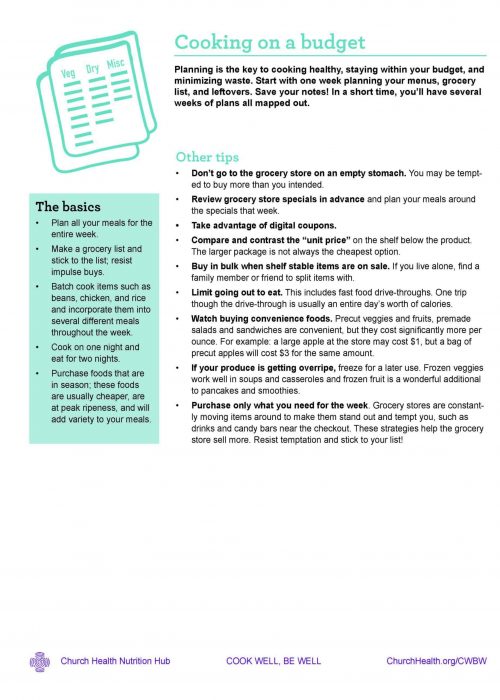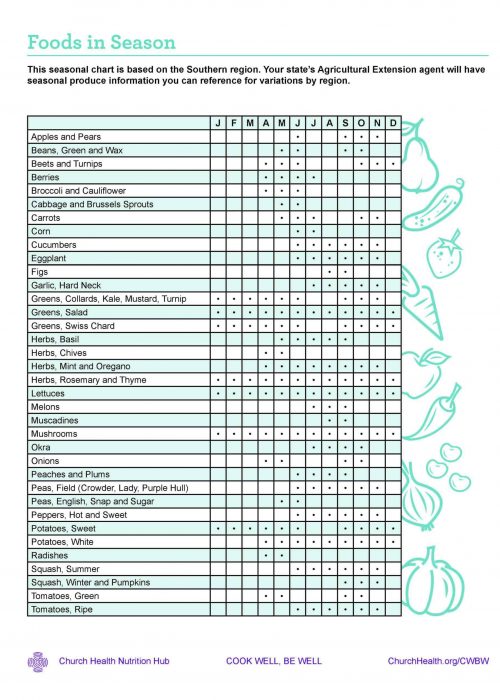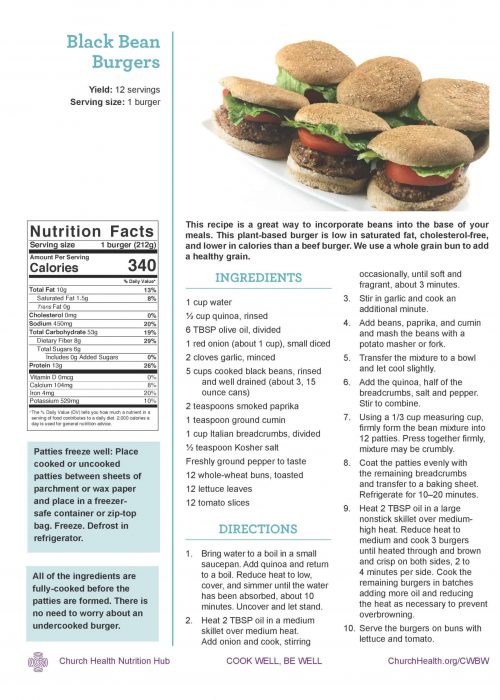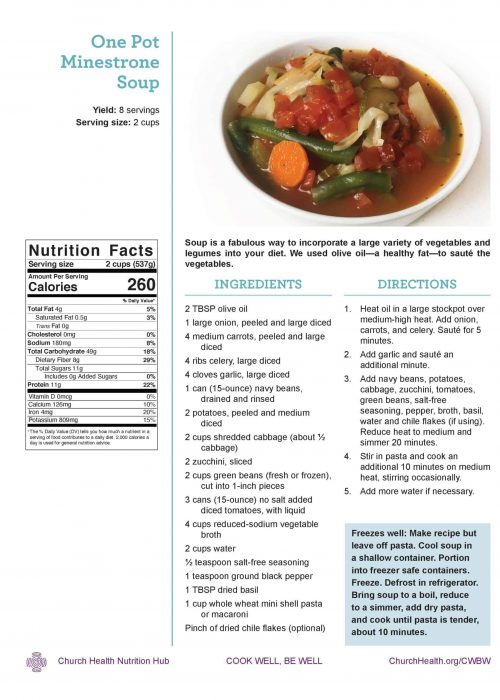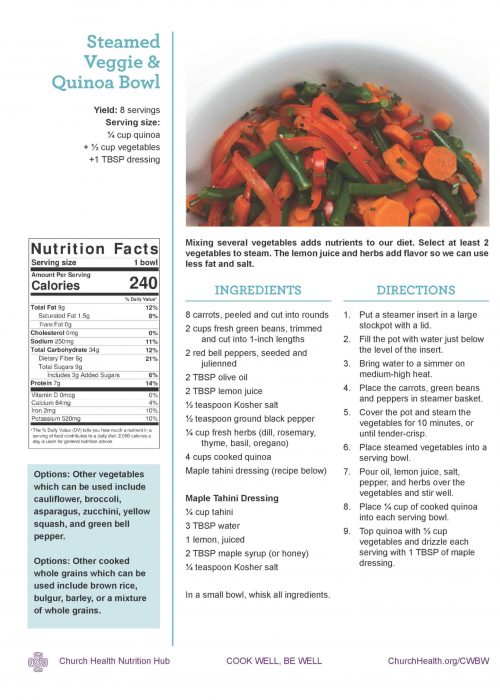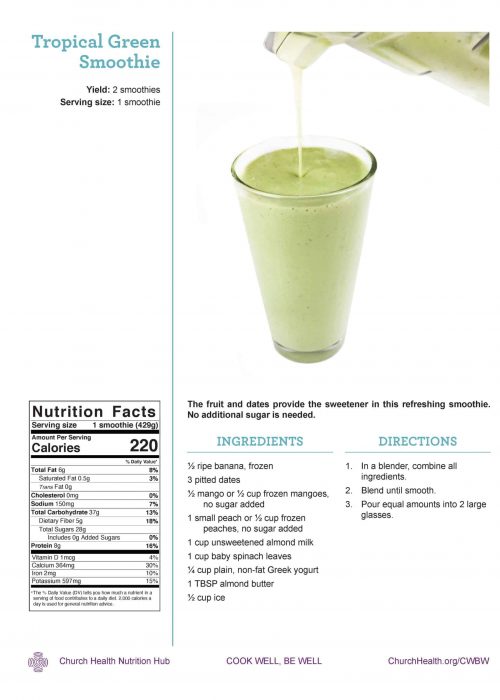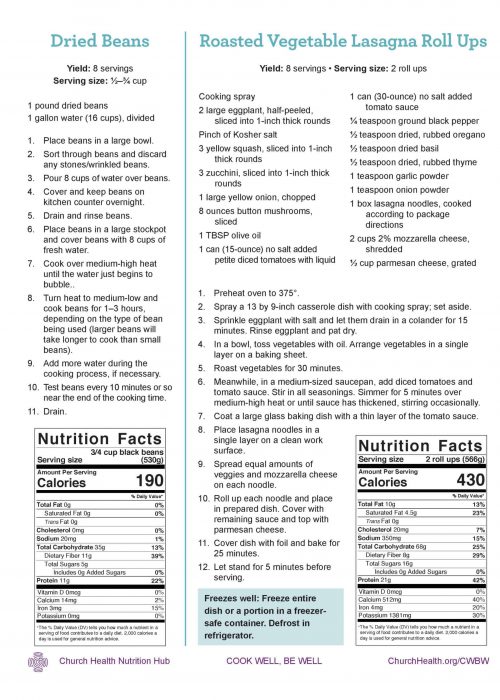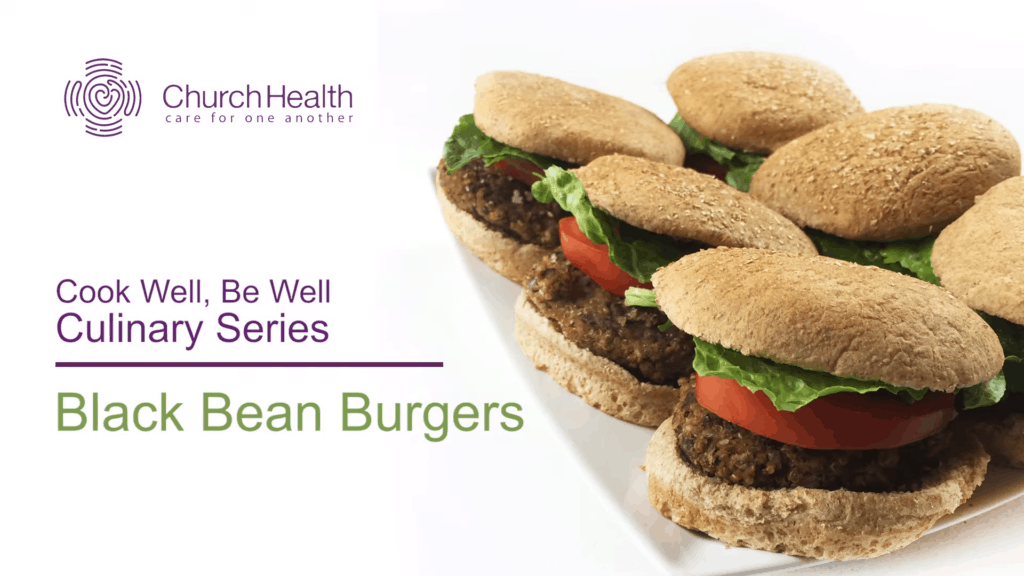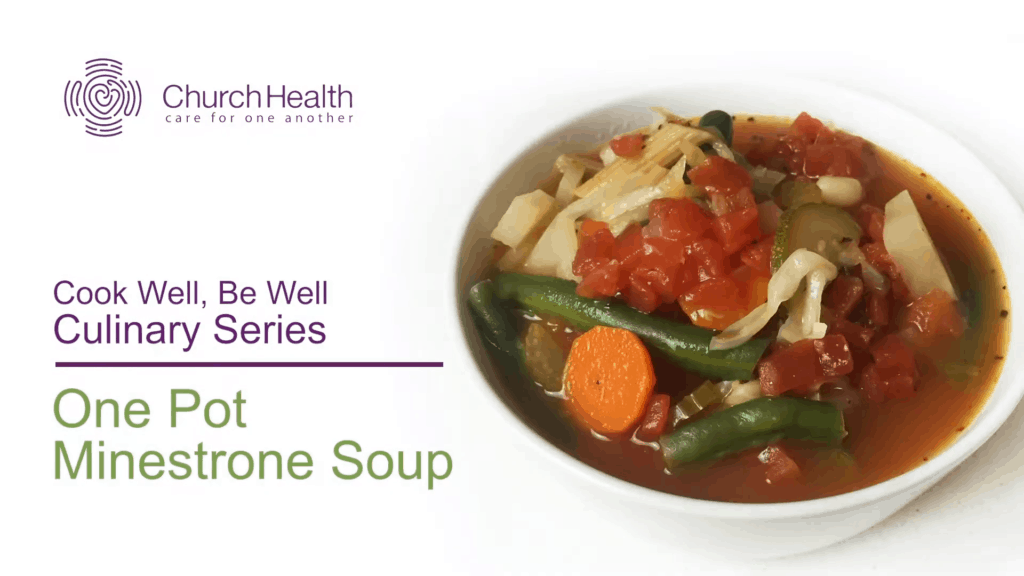Week 1 Handouts
Model for Healthy Living
The Model for Healthy Living is a tool that shows us the interconnectedness of life by focusing on seven key dimensions.
The Mediterranean Diet — Weekly Goals
The Mediterranean Diet is good for many types of eating plans, including those for diabetes, hypertension, and cardiovascular disease. Check off each box (or half a box, it all adds up) as you eat during a week
The Mediterranean Diet: 9 Principles
The Mediterranean Diet emphasizes: DAILY consumption of vegetables, fruits, whole grains and healthy fats; WEEKLY consumption of fish, poultry, beans, and eggs; MODERATE portions of dairy products; and LIMITED intake of red meat.
Week 1 Recipes
These recipes focus on using marinades and sauces to add flavor and using grilling (or sautéing) as a healthier, low-fat cooking technique.
Warm Autumn Salad with Lemon Tahini Dressing
Dark leafy greens—such as spinach—contain many valuable nutrients. Toasting brings out the flavor of walnuts—which are a healthy fat. Salad dressing made with olive oil, which is a healthy, monounsaturated fat; is a healthier option than a creamy salad dressing such as ranch or blue cheese.
Guacamole Dip and Baked Tortilla Chips
Avocados—which contain healthy, plant-based fat—are the main ingredient in this versatile dip, which is great on burgers, quesadillas, or tacos.
Roasted Vegetable Tacos
Roasting caramelizes the natural sugars in vegetables (which are lost in water when vegetables are boiled). Roasting a mixture of vegetables provides an easy way to add flavor plus vitamins and minerals to your diet—as a side dish, mixed into eggs or grains, or as the center of the plate.
Apple and Carrot Muffins
Replacing some of the oil in a recipe with mashed bananas will reduce the amount of fat and calories in the muffins. Adding chopped apples and shredded carrots to the muffin batter adds texture and additional nutrients. Whole wheat flour contributes to your whole grain requirement for the day.
Week 1 Extra Recipes
Additional recipes to practice your skills from Week 1: Cucumber Mint Water, Red Wine Vinaigrette, Salt-Free Taco Seasoning
Week 2 Handouts
Essential Cooking Tools
For the novice cook, getting started in the kitchen can be a daunting challenge, but the task is made more difficult without having the right tools for the job. How do you know what you truly need?
Food Safety
Undercooked or mishandled meat, poultry, egg dishes, and vegetables can become a haven for pathogens that cause foodborne illnesses. Every year thousands of people in the US become ill after eating these foods. Here are some guidelines to help you avoid the risk.
Hand Guide Portion Control
This chart shows portion sizes with easy to remember comparisons using our hand.
Seafood Nutrients
This chart shows the nutrient profiles of several different types of seafood. The rows highlighted in yellow are leaner types. The rows highlighted in green are fattier, but tend to contain higher amounts of omega-3.
Week 2 Recipes
These recipes focus on using marinades and sauces to add flavor and using grilling (or sautéing) as a healthier, low-fat cooking technique.
Chickpea Salad Wrap
This recipe highlights using legumes as the main protein in your meal. The chickpea mixture can be used on a salad or in a wrap.
Grilled Lemon- Herb Chicken
This quick recipe demonstrates the flavor-boosting power of marinades Nutrition Facts and spotlights an easy, effective grilling technique.
White Sauce
This creamy sauce is the base for many staples, including mac-andcheese, veggie lasagna, and scalloped potatoes. You can substitute plant-based milks, such as soy and almond, according to your taste or dietary needs.
Grilled Vegetable Sandwich
Making vegetables using this technique is an easy way to create a delicious vegetarian entrée that boosts your vegetable intake.
Basil Pesto
“Pesto” means paste. This is an Italian favorite that packs a powerful flavor punch and helps you utilize herbs in a creative way. Prepare this recipe when basil is in season and freeze for use throughout the year. Experiment with different greens like arugula and kale to boost the nutrition and taste.
Hummus
Though usually made with chickpeas, hummus can also be made with other beans such as great northern beans, black eyed peas, edamame, or white beans.
Easy Tomato Sauce
This is a basic sauce for pasta that allows for lots of experimentation. Add sautéed vegetables like carrots and red bell pepper. Add lean ground meat, such as turkey, or cooked lentils for a heartier meal. You can use canned tomatoes or overripe fresh tomatoes.
Grilled Portabella Mushrooms
The portabella mushroom soaks up the flavor of the marinade. Grilling highlights the mushroom’s meaty texture and provides a substantial vegetarian alternative to meat. The grilled and marinated mushroom is also great on a sandwich or with pasta.
Chickpea Salad Wrap
This recipe highlights using legumes as the main protein in your meal. The chickpea mixture can be used on a salad or in a wrap.
Week 2 Extra Recipes
Additional recipes to practice your skills from Week 2: Spinach Salad with Peaches and Berries, Strawberry Lime Water, Spring Rolls (Salad Rolls), Asian Peanut Sauce, Grilled Eggplant and Zucchini, Grilled Balsamic Flank Steak
Week 3 Handouts
Fat Profiles
Using this chart, you can compare and contrast some of the most common sources of fat. The dark purple line represents saturated fat. The blue line represents monounsaturated fats while the yellow line represents polyunsaturated fats. Ideally, choose fats with less of the purple color and more of the blue and yellow colors.
Healthy Fats 101
Fat has traditionally received a bad reputation in the nutrition world. You’ve likely seen a large variety of reduced-fat or low-fat products on the market. However, healthy fats are vital to our health and have many roles in the body. There is no reason to fear them!
How to Stock Your Kitchen
By stocking your kitchen with healthy essentials and meal builders that you use frequently, nutritious meals with plenty of variety and flavor can be easier to put together quickly.
Top Spices and Herbs
Spices and herbs are the key to adding flavor to your food and reducing the need for salt. Spices are the dried part of the plant or seed. Spices add pungent aromas and flavors. Herbs are the leafy green part of aromatic plants and are used for flavor, fragrance, and as garnishes.
Using Canned Foods
Canned foods are picked at the peak of ripeness, ensuring the best flavor and nutrient quality. The nutrients in canned items are comparable to fresh and frozen foods.
Week 3 Recipes
These recipes focus on using ingredients that you can keep on hand and won’t need a special trip to the grocery store.
White Beans and Brussels Sprouts
This is the side dish to accompany the braised chicken thighs. You can substitute any bean—chickpeas, black eyed peas, great northern beans. Brussels sprouts are one of the superfoods and are packed with nutrients.
Sautéed Apples with Cinnamon Yogurt Cream
Seasonal fruit prepared simply can make a healthier dessert than cake or pie. Feel free to jazz up your yogurt with different spices—vanilla or almond extract, cardamom, lemon or orange zest.
Braised Chicken Thighs
Braising starts with searing at a high temperature to develop caramelization, then moves to low, slow cooking to tenderize meats tender and create a flavorful liquid.
Chipotle Shakshuka
This Mediterranean version of a one-pot dish can be adapted in many ways by adding additional vegetables or spices and can be enjoyed for breakfast, lunch, or dinner.
Shrimp Fajita Bowl with Black Beans and Cilantro Brown Rice
This is a great way to have your favorite foods in a healthier way with lots of spice, whole grains, and vegetables. Omit the shrimp for an all-veggie meal, or substitute fish for the shrimp.
Week 3 Extra Recipes
Additional recipes to practice your skills from Week 3: Brown Rice, Stewed Cabbage, Ginger Tea
Week 4 Handouts
10 Things to Do with Cooked Chicken
Whole chicken is less expensive than chicken pieces. A whole chicken can be cooked in a crockpot, then shredded for the meals below. Save the broth!
Cooking on a budget
Planning is the key to cooking healthy, staying within your budget, and minimizing waste. Start with one week planning your menus, grocery list, and leftovers. Save your notes! In a short time, you’ll have several weeks of plans all mapped out.
Foods in Season
This seasonal chart is based on the Southern region. Your state’s Agricultural Extension agent will have seasonal produce information you can reference for variations by region.
Week 4 Recipes
These recipes focus on using ingredients that are in season, a good way to use up leftover vegetables, and items you can freeze for healthy meals at a later date.
Black Bean Burgers
This recipe is a great way to incorporate beans into the base of your meals. This plant-based burger is low in saturated fat, cholesterol-free, and lower in calories than a beef burger. We use a whole grain bun to add a healthy grain.
One Pot Minestrone Soup
Soup is a fabulous way to incorporate a large variety of vegetables and legumes into your diet. We used olive oil—a healthy fat—to sauté the vegetables.
Seasonal Frittata
Eggs are high in protein and low in calories. Adding herbs to the frittata adds flavor so we can use less salt and cheese in the recipe.
Steamed Veggie & Quinoa Bowl
Mixing several vegetables adds nutrients to our diet. Select at least 2 vegetables to steam. The lemon juice and herbs add flavor so we can use less fat and salt.
Tropical Green Smoothie
The fruit and dates provide the sweetener in this refreshing smoothie. No additional sugar is needed.
Week 4 Extra Recipes
Additional recipes to practice your skills from Week 4: Dried Beans, Roasted Vegetable Lasagna Roll Ups
Cook Well, Be Well Skills Videos
At any time, view a skills video that to learn how to cut or prepare new ingredients in your recipe. Each video is about 30 seconds.
